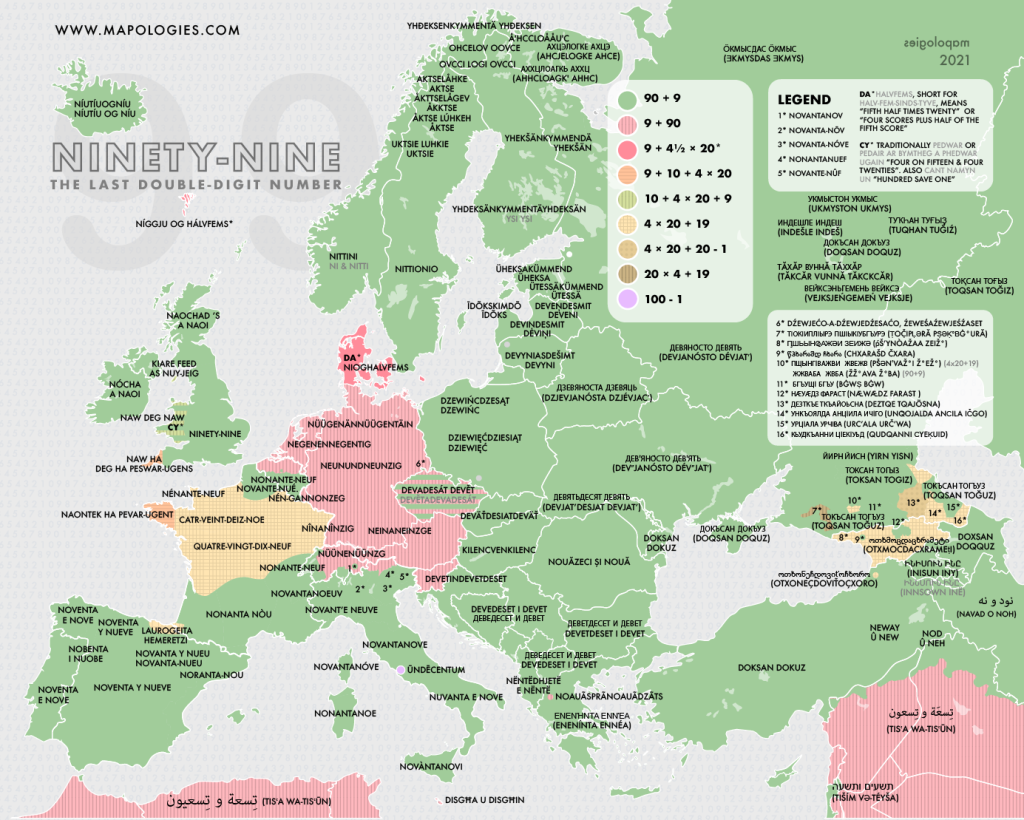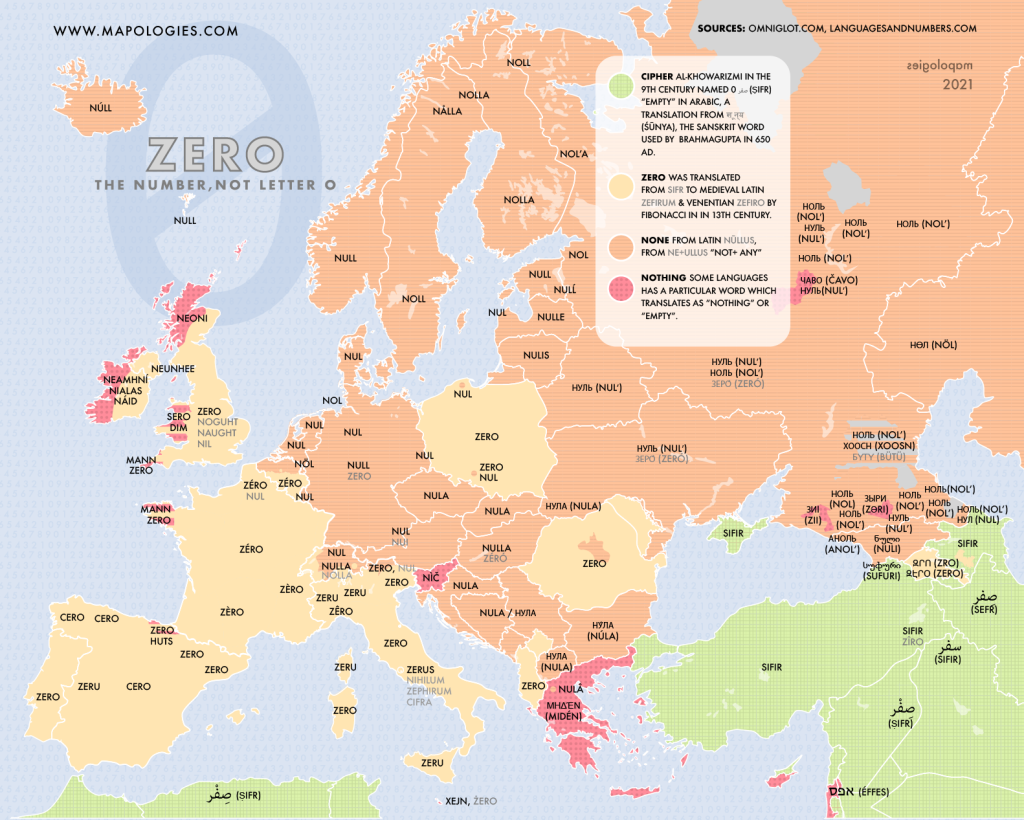From eleven to nineteen

We can classify languages according to the way numbers from 10 to 19 are composed. Often languages compose numbers higher than 10 just adding “ten” to simple numbers from one to nine. But not all languages do this.
In English, teen is added at the end to the numbers to form the first tens (Notice that 13 is thirteen and not threeteen). Except eleven, which comes from Proto-Germanic *aina+lif “one+left”. The same happens with twelve, that from Proto-Germanic *twa+lif “two+left”. It occurs also in other Germanic languages.
On the other hand, most Romance languages came from the Vulgar Latin system. Classical Latin had a simple system: Like in English, –decim is added at the end. However Octodecim and novendecim were rare, it was more common to count down from 20: 18 was duodēvīgintī “two from twenty” and 19 ūndēvīgintī “one from twenty”. Later, Classical evolved into Vulgar and the main change was that higher numbers were formed with dece (et) “ten (and)”. However the limit between the numbers formed with –decim and the dece et was not clear. 16 was sedecim or dece (et) ses. Thus Romance languages inherited this ambiguity: usually from 17 and in the Ibero-romance from 16.
Source: www.languagesandnumbers.com
Ninety-nine

The most common system to make numbers, green on the map, is to start with the tens and after the units, like in English ninety-nine. German and Arabic, in red, are well-known because they place the units before the tens: neunundneunzig literally “nine and ninety”.
Other languages do not have a particular order, but a different way to compose numbers. In English adding -ty to the number nine forms the ten. It is not the case in French, which is based on a vigesimal system: 80 is quatre-vingt (literally four-twenty), thus 90 is quatre-vingt-dix (four-twenty-ten), and 99 quatre-vingt-dix-neuf (four-twenty-ten-nine). Also use a vigesimal system Basque, Georgian, Abchaz, Avar and Lezgian.
Breton and Cornish, like in French, use the vigesimal system but units go before, like in German: naontek ha pevar-ugent (literally nineteen and four-twenty). Similar to Breton, Danish and also Faroese languages follow the German model of units before the tens, which uses the vigesimal system. However, the etymological origin of the names is very very special. You can find more information here.
Some unique cases
Welsh maintains two ways of counting: the modern one is the same as English: nawdeg naw (9-10-9). The traditional one is vigesimal system but the order is reversed in a different way: 90 is deg a phedwar ugain (ten on four twenties).
One language does not call 19 nine+ten, but one-to-twenty. It is Chechen and uses a vigesimal system: дезткъе ткъайоьсна (deztq̇e tq̇ajösna) two words which can be translated as “four-twenty” and “before twenty”. Also in the Caucasus, we can find another unusual way to count. In Adyghe instead of “four twenty” they say “twenty four”. 80 is токIиплI (tokIiplI).
Almost forgotten is the number 99 in the dead language Latin: undecentum (literally one-to-hundred). Typical Roman ingenuity.
Zero

Nobody has ever told the epic tale of the number zero: It all began in the exotic land of Arabs. In their travels around the Indian Ocean coast, they learn the word “ṣifr” in India, from śūnya (Sanskrit: शून्य). Guided by the brilliant mind of the Italian mathematician Fibonacci, it found its way into the heart of the Tuscany, in Latin “zephirum” and in Italian as “zefiro”. It might have been the French who shortened it and the result was our contemporary “zéro.” But wait, there’s more! The story takes an unexpected twist. Latin did not have a symbol for zero, it had literally nothing: “nullus,” a word that fuses “ne” with “ullus” (meaning “not” and “any”).
Therefore modern languages have then three terms to choose from: sifr, zephirum, and nullus. There are some curious situations: Even if English & Polish belongs to the “zero” Alliance, their relatives, Germanic and Slavic languages respectively, belongs to the “null” block. Still, in this naming war, some languages pick neutrality, and opt for their own local term, which usually means “nothing”. Just as in English, we have “nought” or “naught”, Greek has “μηδέν (midén)” and Sloven “nič“. Check the languages marked in red for more.
One

The concept of “one” is laden with symbolism and meaning. It represents uniqueness, singularity, and the essence of individuality. “I” represents “one” in Roman numeral and the first person singular “I” in English. “One” is the first, the origin, and the beginning—an etymological thread connecting us to ancient roots. In its simplicity, it resembles a solitary stick, standing tall as a symbol of unity but also it evokes a sense of solitude. Its connotations, though, stretch across various languages and cultures. One is unity and uniqueness.
The unity of the number is represented by the ancient Proto-Indo-European language, the word for “one” was “oynos.” This ancient term formed the basis for several language families, including Latin language, that gave rise from the word “unus” to many different terms in Romance languages. Also the rest of the European languages. On the map, they are colored with different shades of pink, red, and orange. They cover most of it, but not all.
Meanwhile, the uniqueness and singularity are symbolized by other linguistic roots: In Turkic languages, the ancient root is “bir” has transformed into “bir” in modern Turkish and Kazakh. The languages, spoken in the mountainous regions of the Caucasus employed various terms but all come from “cHǝ̆”. Also, the neighboring Georgian language shines with its own term for one: “erti.” Moving further, we encounter the Finno-Ugric language family, where all the words word originated from “ukte“. Within this family, Hungarian stands out as a member, using “egy”. The Basque language, as often happens, stands alone too: “bat“.
One or a?

Two

Although at first glance dva and zwei may appear distinct from “two“, they share a common linguistic ancestry traced back to the Proto-Indo-European root, dwóh₁. This root has given rise to a diverse array of forms across Europe and Asia. We can separate in two big areas: Reddish and greenish.
In the realm of “reddish-colored” languages, dwóh₁ has evolved into several forms, reflecting the rich tapestry of linguistic diversity. For instance, in Latin, the word for two is “duo,” while in Spanish, it becomes “dos.” In French, it takes the form of “deux,” and in Italian, it is “due.” These variations showcase the intricate development of language over millennia, as well as the interconnectedness of cultures.
In the domain of “greenish and blue languages,” distinct linguistic origins have independently shaped their unique expressions of the number two. Notably, Basque and Georgian. Hungarian and Finnish, among others, belong to a broader linguistic cluster, which emerged from *kakta. Turkish also belongs to a big separate group of languages derived from *ekki.
Hundred

Thousand

Three thousand





A ver cuando se entera que además del idioma que hablan en Noreste de España, hay más idiomas anteriores un poco más al Sur. Mucha pena me da la persona que no se informa.
Saludos mínimos hasta que lo solucionen.
Different languages and countries have the long or short scales for large numbers. It’s beginning with 1,000,000,000 (billion in English). I want a map of European languages and whether they use the long or short scales for large numbers, or another numbering system. And also a map of European languages with the words for the numbers googol and googolplex. I proudly learn languages and I also enjoy numbers.